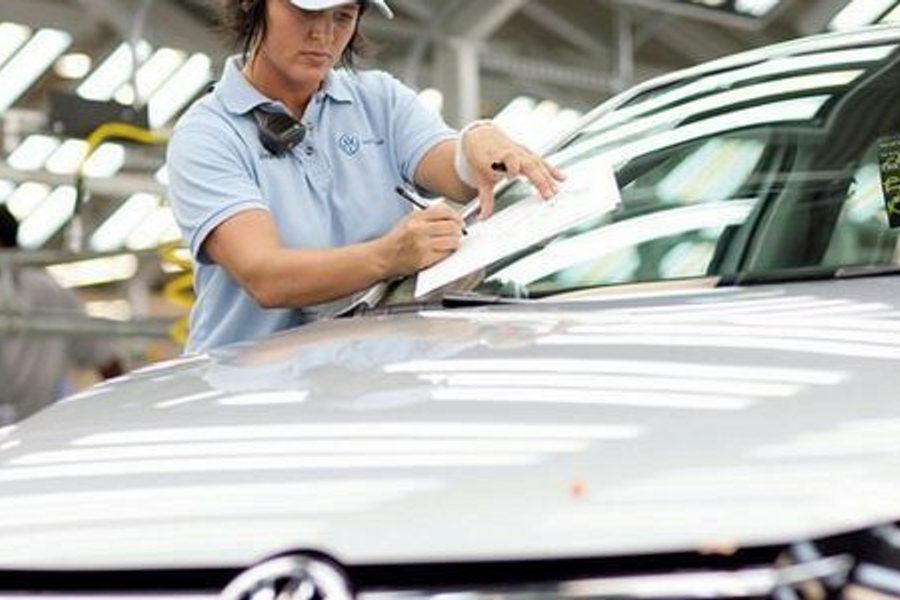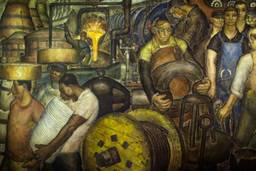
First published at Jacobin.
What a long strange trip it has been for the United Auto Workers. The UAW, the pride of the labor movement during the New Deal order, has gone from the great sit-down strike at the 45,000-strong GM plant at Flint in 1937 — which ratified the concept of industrial organizing of all wage workers at a plant (even if it took years for a majority to join) — to the small, but perhaps significant, victory of 164 skilled-trade workers at the Volkswagen plant in Chattanooga, Tenn.
In the election two weeks ago, 71 percent of these workers voted to join the union. Together they represent only 11 percent of the facility’s 1,450 workers. But a win is a win, and this is the first one the UAW has had at any of the current “transplants” — foreign car companies with manufacturing operations in the US — that, together, employ about a third of the employees in the American automobile manufacturing sector.
Early last year, the union lost an all-unit vote at the plant by a 53 to 47 percent margin, despite the ostensible support of VW’s top management in the Germany of the shaky, but still somewhat functional, “social market” constructed following the Second World War.
At the time, I argued that the UAW had solved one organizing problem while paradoxically creating another: it had neutralized the normally ferociously anti-union campaign of most American-based companies. But it left itself with an insufficiently affirmative argument to convince a majority of workers that supporting the union was worth the dues money.
A union-hating boss can galvanize a union drive. A neutral, almost friendly Volkswagen, working in concert with the union, was also a reasonable, sort of rational boss — if that were the case, a number of workers must have thought, then why do we need a union at all? Especially when they, like the rest of the country, had seen the severe wage and benefit cuts the UAW accepted from the Big Three domestic auto companies as part of the bailout of General Motors and Chrysler engineered by the Obama administration.
The UAW also could not stop Tennessee’s reactionary, anti-union ruling class from assuming for itself the union-busting duties usually undertaken directly by the company. National and state GOP politicians threatened economic retaliation against VW if its workers voted to unionize. This was an outsourced unfair labor practice, but the law does not provide protection against the hostile political context within which American unions must operate, especially in the South.
So this time, the UAW forged a different plan: organize only a small, highly motivated section of the workforce, win an election, and thereby get its foot inside VW’s door. Once the other workers, it was thought, saw the benefits of unionization, enough of them would be swayed to create a durable pro-union majority, and the UAW could organize the whole shop.
And before this election, rather than the recent history of concessions anti-union workers could point to, the UAW, capitalizing on a robust recovery in the auto industry, had just signed agreements with the Big Three that contained substantial hourly wage increases, as well as bonuses, in some cases, as high as $8,000 per worker.
So the context was a better one for the UAW. The organizing challenge was circumscribed and aimed precisely at interested workers, and the politicians stayed out this time, perhaps seeing a small unit as of little concern.
Yet, to add a further irony to a CIO union organizing by craft rather than the entire industrial unit, this time around Volkswagen opposed the union — essentially on the grounds that the organizing unit did not cover all of the workers.
The company is going to appeal the election (no doubt fruitlessly to Obama’s National Labor Relations Board, which supports micro-units) and issued a statement saying, “We believe that a union of only maintenance employees fractures our workforce and does not take into account the overwhelming community of interest shared between our maintenance and production employees.” Which, oddly enough, is true and something that any UAW official would probably say too under any other circumstance.
So why would the German company oppose an organizing drive that would unionize barely a tenth of the workforce and support one that would have unionized all of it? We can’t be entirely certain, but it is likely that the Germans — used to a sometimes irritating but highly rational labor management system of full unionization to set sectoral wage rates, works councils to handle specific workplace issues, and codetermination at the corporate level — think the ad hoc, fragmented, plant-by-plant nature of American unionism is, well, nuts.
No company would prefer to negotiate a union contract with a tenth of its workers and have an entirely different non-unionized relationship with the other 90 percent. There is also the ongoing VW emissions scandal, which, for the company, probably made the idea of contract negotiations with its erstwhile buddies, the UAW, just a headache to avoid.
But the UAW, to steal a cliché from sports media about a team that plays inconsistently, did what it had to do to win — that is, establish itself as a bargaining agent with any group of workers, however small, at any foreign transplant facility. VW was always the most amenable to a union (and, in fact, was organized by the UAW at its now-defunct Pennsylvania plant), and it’s not surprising that, after the relatively close defeat last year, the union would finally break through in Chattanooga.
What does the victory mean for the UAW and for labor generally? It is a small, good thing. It will no doubt energize union activists in other transplants, such as the Nissan plant in Canton, MS, where the unionhas had an organizing program for several years. It will also energize the staff and leadership at Solidarity House in Detroit.
But enormous increases in productivity and the globalizing of the Big Three’s car manufacturing since the days of Flint mean that there are just far fewer autoworkers for the UAW to try to organize, even with the inverted American presence of manufacturing facilities representing every major auto company in the world.
Manufacturing workers generally now account for less than 9 percent of the entire US workforce, well down from almost a third in the early 1950s. Retail and health care each generate substantially larger percentages of US GDP than does manufacturing at 12 percent.
Toyota and Honda, the biggest of the transplant companies, who have invested multiple billions of dollars in investment and production in the States, together employ only about ten thousand workers more than worked in Flint’s GM plant in 1937 alone. And Chrysler’s entire US manufacturing workforce could now fit inside of that Flint plant. In short, the auto industry, while still substantial, and with ancillary effects on other sectors, is no longer central. The Fordist era is over.
More broadly, union organizing happens most efficiently on a large scale when, infusing an already militant working class with possibility and moxie, it spreads rapidly from state to state, city to city, sector to sector, workplace to workplace.
In 1934, three massive, historic workers’ actions — the Minneapolis trucking (and later general) strike; the West Coast longshoremen (and later San Francisco general) strike; and the Toledo Auto Lite strike, each involving thousands of workers in different states and commanding the attention of the companies involved and the violent policing authority of local officials — all began within a few weeks of each other in April and May of that year.
The nation watched raptly, seeing newsreels of these strikes in their local theaters and reading about them on the front pages of the daily newspapers. And some of those paying attention to workers controlling major cities and having pitched battles with police were themselves workers who would strike and struggle later that year. In response, Congress, with the reluctant but critical support of FDR, passed the Wagner Act the following year.
Good organizers exploit the determination and courage of already militant workers — they construct a wildfire. That is the oxymoron of union power. The UAW must continue to do what it’s doing, and other unions must keep pushing forward with their long-in-gestation organizing projects. The non-organizing, yet significant Fight for 15 campaign, the actions versus Walmart, and the ideas for new policy by labor’s most creative thinkers must go on, too.
But the victory of the subunit at VW is only a small good thing because nobody knows today how to construct a wildfire like the one the nation saw in 1934 and 1937 and, earlier, in 1877, 1886, and 1919. Those wildfires are how labor transforms the nation. For now, we can acknowledge that a bit of kindling was lit in Chattanooga. And you can’t start a fire without a spark.





